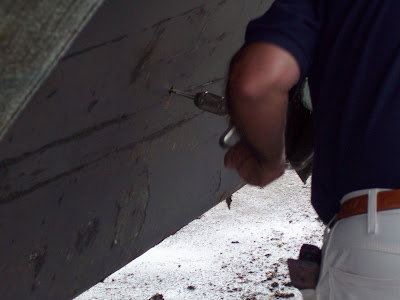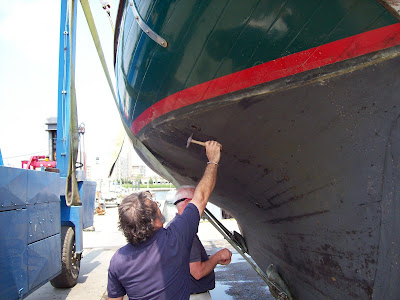 Now that the mast is out, I have spent a week taking anything out of the interior that could rattle, rub, break loose, shift, or cause mayhem. This list includes a large part of the vessels interior. The boom and the gaff had to be packed inside the boat and all the lifelines and blocks had to be tied and seized so they wouldn't come loose during travel and wear a hole in something. For me it was a great week all by myself. I slept in the boat at night and had the entire seashore to myself. It was a time of reflection and rejuvenation, and of course a great time spent messing about in a boat.
Now that the mast is out, I have spent a week taking anything out of the interior that could rattle, rub, break loose, shift, or cause mayhem. This list includes a large part of the vessels interior. The boom and the gaff had to be packed inside the boat and all the lifelines and blocks had to be tied and seized so they wouldn't come loose during travel and wear a hole in something. For me it was a great week all by myself. I slept in the boat at night and had the entire seashore to myself. It was a time of reflection and rejuvenation, and of course a great time spent messing about in a boat. Thursday, December 28, 2006
Moving a Sailboat 4 - 498
 Now that the mast is out, I have spent a week taking anything out of the interior that could rattle, rub, break loose, shift, or cause mayhem. This list includes a large part of the vessels interior. The boom and the gaff had to be packed inside the boat and all the lifelines and blocks had to be tied and seized so they wouldn't come loose during travel and wear a hole in something. For me it was a great week all by myself. I slept in the boat at night and had the entire seashore to myself. It was a time of reflection and rejuvenation, and of course a great time spent messing about in a boat.
Now that the mast is out, I have spent a week taking anything out of the interior that could rattle, rub, break loose, shift, or cause mayhem. This list includes a large part of the vessels interior. The boom and the gaff had to be packed inside the boat and all the lifelines and blocks had to be tied and seized so they wouldn't come loose during travel and wear a hole in something. For me it was a great week all by myself. I slept in the boat at night and had the entire seashore to myself. It was a time of reflection and rejuvenation, and of course a great time spent messing about in a boat. Friday, December 22, 2006
The boatyard is a playground.
Moving a Vessel 3 - 504
Thursday, December 21, 2006
Moving a Boat Part 2 - 505
 The next step to transporting a wooden boat is to pressure wash the bottom of the boat (gently so you don't blast the cotton caulking out) and apply linseed oil. I used a mixture of 75% linseed oil to 25% mineral spirits. (The recipe given me by my surveyor.) About half of the "experts" tell me I should use boiled linseed oil. The other half tell me to use regular linseed oil. This tells me that it doesn't make a difference. Use what you can get - in my case boiled. I applied five gallons of this mixture in four coats. I learned that the easiest way to apply is with a thick nap paint roller applied from the bottom of the boat and rolling up, then the side of the boat doesn't drip all over you. The linseed oil keeps the boat from drying out quickly, and it looks good.
The next step to transporting a wooden boat is to pressure wash the bottom of the boat (gently so you don't blast the cotton caulking out) and apply linseed oil. I used a mixture of 75% linseed oil to 25% mineral spirits. (The recipe given me by my surveyor.) About half of the "experts" tell me I should use boiled linseed oil. The other half tell me to use regular linseed oil. This tells me that it doesn't make a difference. Use what you can get - in my case boiled. I applied five gallons of this mixture in four coats. I learned that the easiest way to apply is with a thick nap paint roller applied from the bottom of the boat and rolling up, then the side of the boat doesn't drip all over you. The linseed oil keeps the boat from drying out quickly, and it looks good.
Labels:
boat buying,
boat transport,
wooden boat maintenance
Tuesday, December 19, 2006
Moving a Ship Part 1 - 507
 This is the first step to getting a boat from Massachusets to Michigan. You have to get it out of the water. The first thing I found out is that everybody is not willing to lift a wooden boat. Apparently many wooden boats are soft mush piles that have been neglected and in some state of sinking for many years and the last thing you want to do is stress the boat by lifting. No amount of talking could convince some marinas to lift me out and set my vessel on a semi. Foster Rigging and Yacht Service is one place that convinced me they had the know how to lift my boat without damaging it and set it on a semi. They are EXTREMELY expensive though.
This is the first step to getting a boat from Massachusets to Michigan. You have to get it out of the water. The first thing I found out is that everybody is not willing to lift a wooden boat. Apparently many wooden boats are soft mush piles that have been neglected and in some state of sinking for many years and the last thing you want to do is stress the boat by lifting. No amount of talking could convince some marinas to lift me out and set my vessel on a semi. Foster Rigging and Yacht Service is one place that convinced me they had the know how to lift my boat without damaging it and set it on a semi. They are EXTREMELY expensive though. Everything went well.
Monday, December 18, 2006
Repairing the Rot - 508


The great part about a wooden boat is that it is made up of individual pieces. Each piece can be inspected and if necessary, replaced. In this case, luckily the plank was pretty short and can be removed relatively easy and replaced. Notice the lack of fiberglass dust, grinding, epoxy or fiberglass resin or face masks and tyvec suits. Just some sawdust, a piece of wood, and some cotton. Ahhhhhhh. . . .
Edit: When the board was removed, it wasn't actually rotten. The outer layer of wood had separated on the edge making it feel soft. If I had known better, I would have left this piece alone. Especially since the end of this wood just covers over another solid piece of wood.
Labels:
carvel planking,
plank repair,
wooden boat
Saturday, December 16, 2006
Listening to the Surveyor - 510

This X mark so unceremoniously scratched on the hull of our boat is a rotten spot. The boat is not perfect. Stomach churns. Owner shifts weight from foot to foot. World shifts on axis. Etc. I did what everyone else suffering from Sailboat seizure does - I bought the boat anyway.
Edit: When the board was removed, it wasn't actually rotten. The outer layer of wood had separated on the edge making it feel soft. If I had known better, I would have left this piece alone. Especially since the end of this wood just covers over another solid piece of wood.
Friday, December 15, 2006
How to Buy a Boat 3 - Day 511


When you finally find a surveyor that you think you can trust - pay him or her well. This person is your only defense against a disease that has you completely in your grips. You are at this exact moment suffering from a sailboat seizure (keel induced infarction). The signs that you are suffering from this insipid disease are: 1. You are talking to someone about spending all your money on something that MIGHT hold its value, will most likely lose value and will either end up on a reef or stuck in the mud. 2. You are standing next to a boat that you don't own and would like to own. 3. You have looked at yachtworld.com or have entered a building with the word "broker" anywhere on it.
The surveyor (as soon as he or she is paid) will do something THAT YOU CANNOT DO AT THIS POINT. The surveyor will inspect your vessel and tell you what condition it is really in. The reason you need this is you are suffering from a sailboat seizure, the owner doesn't really know and wouldn't tell you anyway if he did, and the broker may know but he isn't telling the owner or especially you what he knows. (See previous post).
The surveyor does all this with a magical little device called a hammer. He will tap the hammer in a pattern that manages to touch the boat every two square inches. It is amazing to watch, and only someone who is suffering a keel induced infarction will be able to watch another person tap a 30 foot object all day every two square inches with a hammer. But to you at this point it will seem amazing and sound musical.
NEXT, the hard part - listening to the words coming out of the surveyors mouth.
Labels:
bristol channel cutter,
broker,
surveyor
Subscribe to:
Posts (Atom)




